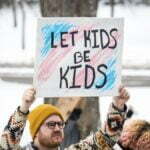The Facts on Fatherlessness, Part Two
Mental, emotional and physical well-being
- From nations as diverse as Finland and South Africa, a number of studies have reported that anywhere from 50 to 80 per cent of psychiatric patients come from broken homes.
- A Canadian study of teenagers discharged from psychiatric hospitals found that only 16 per cent were living with both parents when they were admitted.
- A study of nearly 14,000 Dutch adolescents between the ages of 12 to 19 found that, “In general, children from one parent and stepparent families reported lower self-esteem, more symptoms of anxiety and loneliness, more depressed mood and more suicidal thoughts than children from intact families.”
- A massive longitudinal study undertaken in Sweden involving over one million children found that children from single parents showed increased risks of psychiatric disease, suicide or suicide attempt, injury and addiction. The authors, writing in The Lancet, concluded that growing up in “a single-parent family has disadvantages to the health of the child”. Bear in mind that Sweden is one of the most highly advanced welfare states on earth. Thus even with a comprehensive welfare net, children still suffer when not in two-parent families.
- A US study of 2,733 adolescents found this: “The greater the fathers’ involvement was, the lower the level of adolescents’ behavioral problems, both in terms of aggression and antisocial behavior and negative feelings such as anxiety, depression, and low self-esteem.”
- Researchers at the Children’s Hospital of Los Angeles have shown that fatherlessness is directly related to childhood obesity. Statistical analysis of the data established that “family structure was significantly associated with the obesity rate.” In each grade, children from single-mother families had higher rates of obesity than children from two-parent families.
- A researcher from the University of South Australia’s School of Health Sciences found that children from single families do less well than those from married families because they are less active and do not have as much opportunity for physical activity.
- A more recent Australian study showed that obesity among girls in single-parent households continues to be a major problem. Deakin University health researchers studied nearly 9000 children aged between four and nine and found higher rates of overweight and obesity in girls from single-parent families than those in two-parent families.
- A recent study from Rhode Island found that while “the incidence of mental-health problems ran particularly high (33 percent) among children living with parents reporting high levels of parental stress… the complete story involves not just parental stress. It involves family structure as well: the rate for mental-health problems came in significantly higher among children living with a single mother (25.7 percent) or in a stepfamily (26.6 percent) than it did among children living with two biological or adoptive parents (13.3 percent; p<.001).”
Social costs
- In the UK the costs of family breakdown is astronomical: “The 2012 total cost of family breakdown to the UK was £44 billion (£43.94 billion), up from £42 billion last year. The annual cost per taxpayer is now £1,470.”
- An even newer UK study said this: “Family breakdown is costing taxpayers almost £50 billion a year and the bill is rising fast, a new analysis said yesterday. The costs generated by family breakdown – including subsidised housing, crime, health and social care and disrupted education – have gone up by nearly a quarter in just four years.”
- Dr Bruce Robinson, University of Western Australia, and author of Fathering from the Fast Lane, has estimated the cost of fatherlessness in Australia to be over 13 billion dollars per year.
- In Australia it has been estimated that marriage breakdown costs $2.5 billion annually. Each separation is estimated to cost society some $12,000.
- Also, Australian industry is reported to lose production of more than $1 billion a year due to problems of family breakdown.
- Homelessness is also closely linked with family breakdown. A recent Australian study conducted at two Melbourne universities has found that children whose biological parents stay together are about three times less likely to become homeless than those from other family types.
Child abuse
- A 1994 study of 52,000 children found that those who are most at risk of being abused are those who are not living with both parents.
- A recent American review of the studies found that “fathers, especially married fathers who live with their children, play an important role in protecting their children from abuse and neglect”. It found that 15.5 children out of 1000 children were mistreated in married-parent families, whereas 27.3 children per 1000 were mistreated in single-parent families.
- A Finnish study of nearly 4,000 ninth-grade girls found that “stepfather-daughter incest was about 15 times as common as father-daughter incest”.
- A study examining 126 profiles of perpetrators of fatal assault in United States found that non-biological parents were 17 times more likely to commit a fatal assault toward a child than biological parents.
- In Australia, former Human Rights Commissioner Mr Brian Burdekin has reported a 500 to 600 per cent increase in sexual abuse of girls in families where the adult male was not the natural father.
- A recent study by the Australian Institute of Health and Welfare found that “a relatively high proportion of substantiations [of child abuse] involved children living in female-headed one-parent families and in two-parent step or blended families.”
- And more recent Australian research continues to bear this out: “The data shows that almost half of all proven cases of child abuse and neglect involved ‘broken’ families in 2010-11, even though (according to the ABS Family Characteristics Survey) only 26 per cent of all Australian children lived in sole-parent and step or blended families.”
Conclusion
The evidence of the harmful effects of father absence could fill many pages. The above is just a small sampling of a very large body of research findings on the issue. The social science research on the need for children to be raised by both a biological mother and father, preferably cemented by marriage, is vast and growing.
Indeed, the evidence is so overwhelming that the reader is advised to look at recent summaries of the data. However, several recent academic studies can be mentioned here, which demonstrate the importance of children growing up with their married biological mother and father.
One American study of 19,000 young people conducted by the Bowling Green State University (Ohio) found that teens fare best when living with two married biological parents: “Adolescents in married, two-biological-parent families generally fare better than children in any of the family types examined here, including single-mother, cohabiting stepfather, and married stepfather families. The advantage of marriage appears to exist primarily when the child is the biological offspring of both parents. Our findings are consistent with previous work, which demonstrates children in cohabiting stepparent families fare worse than children living with two married, biological parents.”
Another large-scale American study found that there are “overall disadvantages” in not living with both biological parents. The author concludes, “My analyses have clearly demonstrated some overall disadvantages of living with neither parent. Among adolescents from all six family types, those in non-biological-parent appear to rank the lowest in academic performance, educational aspiration, and locus of control. Further, they appear to fare less well in the remaining outcome areas (self-esteem, behavior problems, and cigarette smoking).”
Cornell University Professor Urie Bronfenbrenner, a leading expert in developmental psychology, summarises the evidence in this fashion:
Controlling for associated factors such as low income, children growing up in [single-parent] households are at greater risk for experiencing a variety of behavioral and educational problems, including extremes of hyperactivity or withdrawal; lack of attentiveness in the classroom; difficulty in deferring gratification; impaired academic achievement; school misbehavior; absenteeism; dropping out; involvement in socially alienated peer groups; and, especially, the so-called ‘teenage syndrome’ of behaviors that tend to hang together – smoking, drinking, early and frequent sexual experience, a cynical attitude to work, adolescent pregnancy, and in the more extreme cases, drugs, suicide, vandalism, violence, and criminal acts.
Similar comments can be made about the situation in Britain. After amassing a wealth of data on the negative effects of fatherlessness in the UK, Rebecca O’Neil makes this concluding remark:
The weight of evidence indicates that the traditional family based upon a married father and mother is still the best environment for raising children, and it forms the soundest basis for the wider society. For many mothers, fathers and children, the ‘fatherless family’ has meant poverty, emotional heartache, ill health, lost opportunities, and a lack of stability. The social fabric – once considered flexible enough to incorporate all types of lifestyles – has been stretched and strained. Although a good society should tolerate people’s rights to live as they wish, it must also hold adults responsible for the consequences of their actions. To do this, society must not shrink from evaluation of the results of these actions. As J.S. Mill argued, a good society must share the lessons learnt from its experience and hold up ideals to which all can aspire.
Wade Horn, the head of the National Fatherhood Initiative in the USA offers this concluding word: “The news is not good when large numbers of children are growing up disconnected from their fathers. It’s not that every child who grows up in a fatherless household is going to have these kinds of difficulties. But it is true that there’s an increased risk of these negative outcomes when kids grow up without fathers.”
With the rise of fatherlessness Australia and the Western world has also experienced a marked rise in social problems. And the brunt of these problems has been borne by children. We owe it to our children to do better. We urgently need to address the twin problems of fatherlessness and family breakdown. Public policy must begin to address these crucial areas. Until we tackle these problems, our children and our societies will continue to suffer.
Part One is here: https://billmuehlenberg.com/2013/05/17/the-facts-on-fatherlessness-part-one/
[1633 words]




















Thanks Bill for bringing this overview of studies to our attention.
The list goes on and on, displaying a sad reflection of the woes of family breakdown, single parent families and women dominated families.
Society’s drive away from Gods laws has profound repercussions.
Where/when did it all start?
My guess is with the world wars, when our nation’s fathers were away from their families for years, many never to return, and of those who did, many never to be the same again. This brought the breaking of many hearts and much anger (wrongly directed) towards God.
Visiting young servicemen, lonely women and girls, absent fathers and husbands and lovers; this is what a generation of children were brought up under, into and among. Many grew up to be involved with the flower power movement and sexual revolution of the 1950’s, 60’s and 70’s.
It is this same generation that now govern our country, seemingly oblivious to the harm that was done to them and by them. And through legislation they now open the door to the increasing disregard of family and of God’s Laws.
May the prophesy given by Smith Wigglesworth come to pass, that the last great move of the Holy Spirit be in this nation of Australia! And may our country return and repent before God, and ask for His forgiveness for the flouting of His Laws. That we may bow our knee and worship the One True God! Amen.
Mark Lambert
I’ve heard some churches run programs to help single mums. Like get a couple of stand up dad’s to do some good things with their children. Maybe a bush walk or a bike ride the list could be endless.
Daniel Kempton
The axing of the baby bonus was probably the most beneficial part of this years budget. I always wished John Howard had been brave enough to only give it to married mothers, as that would have prevented most of the tragic stories that came with it such as “boyfriends beats up the mother of his child to get the baby bonus money etc.”.
It would be wonderful if the Australian people could vote in a government that would be unitedly committed to enabling a father to provide for his family, mansions and BMW not included. 🙂 God’s richest blessings
Ursula Bennett
Good on you Bill, I have always loved to read what you express, and it is always easy to encourage people with such GODly intent as yours. But as i exhort you, remember that what the ignorant folk do to you they did to our wonderful Lord and Creator, and this is ongoing according to Matthew 25:Verses 43-51. We know however that all true CHRISTians would dearly love to see them repent and spend eternity in the presence of our loving GOD and not the evil one.
Francis Colosimo
We produce a quarterly church newsletter and the upcoming one will be issued a little before Fathers Day.
I would very much like to include some of what you have posted here, including some of the quotes from other resources. Would be grateful for your permission to do this.
Many thanks.
Norman Shannon
Yes feel free Norman with proper acknowledgments, links etc.
Bill Muehlenberg, CultureWatch